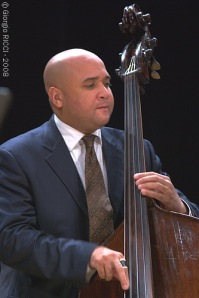Business Strategy
Posted on August 22, 2011. Filed under: Business Strategy, Communications, Marketing Strategy, Small Business | Tags: Ellie Becker, George Cables, Jazz, Kitano Hotel, Lewis Nash, Marketing, Peter Washington, Small Business |

George Cables, Jazz Pianist and Musical Story Teller
On Saturday evening, Jeff and I went into NY City to hear a classic jazz trio – piano, bass and drums — of the highest caliber at the intimate jazz room in the Kitano Hotel. The trio was led by George Cables on piano, who has played with everyone from Art Blakey to Sarah Vaughan to Sonny Rollins. He was joined by the best rhythm section in the business, Peter Washington on stand-up bass and Lewis Nash on drums.
That evening’s performance reminded me again why I love jazz. It is the single most intelligent and creative art form I’ve ever experienced – and when it’s melodic, rhythmic and it swings, it’s heaven on earth. At the highest levels, it demonstrates improvisational qualities that we can all seek to emulate and bring into our work lives. If we’re able to do that, we will surely elevate our business games.
Let me explain. I’ve heard many hundreds of live jazz sets over the years. Every once in awhile, one stands out as spectacular — beyond special. That happened on Saturday. The jazz musicians we heard this weekend have their skills honed and fine tuned to the max – as many of us do in our chosen fields. When they play their solos, their virtuosity is unmistakable. That’s job one for all of us: get our chops up.
It’s what they do in the ensemble environment that provides awesome lessons for business – and, in this political season, for government, too.
Listening

Peter Washington - Listening Enhances Playing
We observed the epitome of active listening. There was an intensity to it – although it seemed effortless. You could see – and hear the result of — the three listening to one another. It enabled them to pick up on a musical phrase played by one and allowed the others to echo it or bend it or transform it.
Do you think this level of listening could boost the results of corporate teams, small businesses and the US Congress? It’s not about what power I can gain by pushing my idea, but what we can all achieve together by listening to each other’s ideas to synthesize new and exciting solutions.
Non-Verbal Cues
There were also non-verbal cues: a nod, a gesture, fingers held up in a silent count. The trio picked them all up and used them to create a polished performance that has never before or will ever again be created. It was seamless and precise. It sounded like they were reading from a score, but they weren’t. They were playing from a basic set of chords and improvising on the fly.
It reminded me of a moment a while back at a meeting with a prospective client, the owner of a business. He had invited key staff members to join us and provide their input. When they got too far from his vision and tolerances, I saw his expression change.
I chose that moment to make eye contact with him to express that I was happy to engage with his staff, but that I recognized that ultimately he was the client and decision maker. In that brief instant, he and I communicated how we would proceed together.
Story Telling
In an hour of music, there was also a lesson in story telling. Several of the tunes were George Cable compositions. Original works by jazz musicians fill the jazz repertoire.
Young players feel compelled to follow in this tradition but don’t really understand what makes a great tune. They think that if they write a theme — a few notes — and improvise on those notes seemingly endlessly, they’ve composed a song worthy of recording. Not!
There is only a handful of musicians who are also great composers; whose songs, in my opinion, are worth recording. Dave Brubeck is one and George Cables is another. The reason they stand out is that they know how to tell a musical story.
Their stories are about something that we can relate to. They have a beginning, a middle and an end. Go to www.georgecables.com. You’ll spontaneously hear part of one of his compositions called Song for Helen. He wrote it for his life partner, a woman whose love saw him through a liver and kidney transplant. You’ve probably never heard it before. But you’ll want to hear it again. You’ll get what their relationship is about. We who create content need to keep story telling top of mind.
Respect

Lewis Nash and Other Great Jazz Players Have Respect for the Talents of Those They Play With and Their Own
The final business lesson from jazz in this post is that none of the above could happen without respect. It all started with musicians who respect one another’s talents and skills. Without that they could not have listened without ego, subjugating their own needs to what they could create as a group. Nor could they have trusted their nonverbal cues to be understood and acted upon.
The story telling part comes from self respect, which allows us to honestly communication our life experiences. I hope you enjoyed this story of a Saturday night out that led to some thoughts that could propel me into a more effective Monday.
What are your passions that give you lessons for your work life? And thanks for sharing one or two.
Read Full Post |
Make a Comment ( 4 so far )
Posted on August 14, 2011. Filed under: Business Strategy, Communications, Content, Human Business, Marketing, Marketing Strategy, Small Business, Social Media, Twitter | Tags: Ellie Becker, Inbound Marketing, Marketing, Small Business, Social Media, Twitter |

Need I Say More?
People use Twitter in different ways. Some go for volume. Get as many followers as possible. This is often part of a monetization strategy and utilizes some automation program or builds from following others’ lists, which is fine.
I’ve made the decision to build a smaller community on Twitter based on mutual interests and the ability to gain and add value. My community is focused on two groups: other marketing professionals and small-to-mid-sized businesses (SMBs), the kind of companies that my business serves.
Perusing my Twitter stream gives me access to information about my profession and my target audiences that I might not ever connect with otherwise. It’s a great listening station. It also affords me the opportunity to give back information and experience-based knowledge, as well as to engage with people who may be able to refer business or to hire me directly. The way I approach Twitter and other social media is in exactly that order.
Before I follow someone, I check their profile to be sure they meet the above criteria. When someone follows me, I also check their profile before following back. Before I thank someone for following me, I check their profile so that I can reference something specific about them that I’m interested in knowing more about or that we share in common.
That’s one of the benefits of cultivating a smaller group of followers. You can get to know them over time. I recognize almost everyone in my Twitter stream and have a good idea of the kinds of information they’ll share or be interested in.
So what ticks me off? Automated ‘Thanks for following’ direct messages. They’re cold and impersonal to me. I feel this way: Why bother thanking me at all? You don’t really care about who I am or what I can share with you. You just connected with me based on some keyword to build your followers. It’s about you…not us. If you are going to thank me, at least make it for the right thing.
I especially hate it when the auto DM contains a further ask: Thanks for following. Now connect with us on Facebook, too, or visit our website, or check out how we can make you a million online with our great software. It reminds me of how annoyed I used to get when I’d drive two hours to visit my dear, departed grandmother and the first thing she’d say to me when I got out of the car wasn’t, “Hello, darling,” but, “So when are you going to come again?”
Call me old fashioned, but I like the idea of community and getting acquainted first. Let me know why you’re looking forward to following each other and I can better deliver on my end of the bargain!
How do you use Twitter? How do you feel about auto DMs that say thank you and sell you more at the same time?
Image ‘Get 4100 Twitter Followers for $12.95″ is from redplasticmonkey under Creative Commons license.
Read Full Post |
Make a Comment ( 8 so far )
Posted on August 11, 2011. Filed under: Business Management, Business Strategy, Communications, Inbound Marketing, Marketing, Marketing Strategy, Small Business, Social Media | Tags: Ellie Becker, HubSpot, human business, Inbound Marketing, Marketing, Morgan Stanley Smith Barney, Pat Morrow, Small Business, Social Media |

Keep Your Marketing Engines Running!
Every time we hit a moment when the stock market crashes – or worse, fluctuates wildly – it’s predictable that smaller businesses will instantly turn off their marketing engines.
This is just as short sighted as selling off stocks the day of the crash and similarly forfeits the upside. The smartest investors and financial advisors, like my networking partner Pat Morrow, who runs a private wealth management practice at Morgan Stanley Smith Barney, are exploring the current landscape for opportunities for their clients. And they’re finding them, too.
On the marketing side, I’m similarly engaged. In this environment, it makes sense that if our competitors panic and stop promoting their businesses, we stand to pick up market share.
The reason that I like Inbound Marketing is that it’s possible to create great efficiencies. Does it take time and money resources? Of course. But if cash flow becomes a problem, or if business slows down a bit, it gives you time to take on some of the marketing tasks that you might otherwise outsource. Pay only for what you can’t do yourself.
Even though I sell marketing services to businesses like yours, I can empathize with you. I’m in the same small business boat. Limited time. Limited resources. But today I took some time to build an email marketing campaign to my opt-in list giving them some reasons to consider Inbound Marketing and my services in an uncertain economy.
My Hubspot content management system allowed me to do this without any assistance. As far as I’m concerned it was a cost effective use of my time. When I got back from some meetings late this afternoon, I sat down and wrote this blog post, which will bring traffic to my site and help me engage with my audiences.
I have no intention of cutting back my marketing efforts. I’m happy to invest to get my company in front of opportunities that will help me build through these uncertain economic times. And I don’t mind putting in some sweat equity.
What can you contribute to your own marketing efforts? Farm out less. But don’t stop marketing.
Image by Nathan E Photography Under Creative Commons License
Read Full Post |
Make a Comment ( 3 so far )
Posted on August 8, 2011. Filed under: Business Strategy, Communications, Human Business, Inbound Marketing, Marketing, Marketing Strategy, Online Marketing, Small Business, Social Media, Uncategorized | Tags: Caramoor, Ellie Becker, Inbound Marketing, James Farm, Jazz, John Coltrane, Johnny Nartman, Jose James, Joshua Redman, Juan Carlos Formell, Mark Murphy, Marketing, New Media, Small Business, Social Media |

Jose James Synthesizes the Old and The New Jazz
I read a recent study revealing that only a small percentage of small businesses are using social media and other online tools for their marketing. Of those who have used or are using online marketing, even a smaller fraction considers the new tools essential.
These statistics support what I’ve been recognizing anecdotally as I speak with small businesses about inbound marketing and new online marketing tools. There’s indeed a resistance to adopting these new methods, even though there’s plenty of evidence that online is where potential buyers are already looking for products and services these days.
I’ve been chalking up this phenomenon of reticence to a need for more education. And I still believe this is true. But a personal experience I had this past weekend triggered another thought: The way to encourage adoption of the new is to synthesize it with familiar experiences and expectations.
Here’s what happened. Jeff and I attended the annual jazz festival at Caramoor, a marvelous summer music venue outside New York City.
The first artist on the bill was a wonderful guitarist from Cuba, Juan Carlos Formell, with a group called Johnny’s Dream Club. All of the tunes were new to us and sung in Spanish. They also shared an enervating sameness of tone and tempo, so although the music was beautifully played, at the end of the set we were happy to move on.
The next set brought James Farm to the stage, a group of fine young players led by the saxophonist Joshua Redman, son of the legendary Dewey Redman and now becoming a legend in his own right. The program notes asked that we, “keep an open mind,” for an hour of original music composed by members of the band. That meant another hour of nothing familiar and in a musical style that had Jeff, a musician and drummer, complaining that he couldn’t even tap his toes or bop his head to it.
We were expecting more of the same in set three, to be performed by a vocalist Jose James, who apparently has been around for awhile, but who neither of us had heard before. The program notes cited his influences, which included Prince, hip-hop, electronica, spoken word jazz and avant garde poetry in addition to jazz standards.
I can’t wait to hear Jose James again and will go to some trouble to seek him out. First of all, he has a marvelous baritone voice, reminiscent of the late Johnny Hartman who recorded an iconic album with the great jazz saxophonist John Coltrane. In fact, Jose James is reviving that collaboration on a tour with former Coltrane pianist McCoy Tyner.
That said, the set was anything but a re-churn of the past. James synthesized all of his contemporary influences with historic expectations of a swinging jazz set to create one of the freshest hours of music I’ve heard in a long time. It was fun to hear street rhythms applied to standards.
His love of spoken word makes him an innovative scat singer qualified to grab the baton from none other than my all time favorite jazz singer, Mark Murphy, who is almost 80 now and whose artistry I’ve shared on this blog – beginning with the second post back in 2009 where you can hear him. The set included covers of well-known R&B tunes, which helped carry us along into less charted waters – an original or two with hip-hop riffs.
During the set, the familiar and the new brilliantly synthesized into something so appealing and energizing that we wanted to embrace it. As I approach existing clients and new prospects about the benefits of applying new marketing approaches to meet their business goals, you can bet that I’ll be referencing marketing basics that still provide a solid foundation for what’s now and what comes next.
How are you synthesizing past and present techniques to motivate wider acceptance of today’s marketing tools?
Read Full Post |
Make a Comment ( 4 so far )
Posted on August 4, 2011. Filed under: Business Management, Business Strategy, Communications, Human Business, Inbound Marketing, Marketing, Marketing Strategy, News, Online Marketing, Small Business | Tags: Ellie Becker, human business, Inbound Marketing, Marketing, Online Marketing |

We can be our own competitive edge!!
The Dow fell more than 500 points today. Bad news was exuding from every media outlet. I had an opportunity to get some perspective on it in my weekly networking group meeting from members who are highly sophisticated financial experts.
Then I came home, shared some conversation with my neighbor on her garden swing, pulled a bunch of weeds that have been bothering me while thinkingabout what my blog topic would be for today. Relaxing and getting still allowed me to realize what was concerning me – and probably you, too.
When markets go crazy and economies are shaky and there’s less business to go around, we can’t help but think about how we’ll compete for what business there is. This has been on my mind for some time and brought to the forefront by today’s events.
Bottom line, I’ve decided not to worry about who else is competing for a piece of the online/inbound marketing pie. Instead, I’m working on my own story. Thinking harder about what I bring to the table that will have value for my clients and that I can speak powerfully about to prospects. I’m thinking about my strengths – what I really do better than anyone I’ve encountered.
Then I’m evaluating my lighter abilities — what I fully understand but need partners to execute well.
And I’m working on my messaging so that I can communicate clearly and effectively. That includes listening and testing… talking to as many people as I can find who are willing to offer feedback as I hone my messages.
I’m asking myself:
- Are my offerings aligned with the needs of my client/prospect?
- Is my language completely understandable, or too jargon-y?
- Am I creating enough curiosity that people will be willing to stick around and learn more?
- Am I explaining my services so that the benefits and value come through loud and clear?
- Am I being human enough to connect and credible enough to build trust?
I believe that refocusing my energies on being as meaningful as possible to my market is my competitive edge.
How are you dealing with the competitive and business realities of the current economic environment?
Image from tableatny under Creative Commons license.
Read Full Post |
Make a Comment ( 2 so far )
Next Entries »







